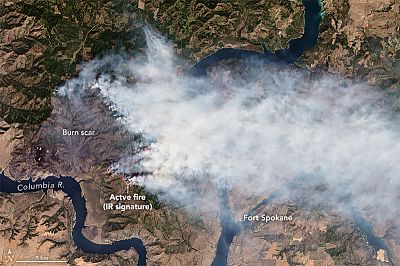New research on the clouds aims to improve forecasts of weather and air quality.
You've seen billowy cumulus clouds and wispy cirrus clouds, but odds are you're not too familiar with fire clouds. Even scientists know less than what they'd like to about so-called pyrocumulonimbus (pyroCb) clouds, which form when wildfires and agricultural fires unleash enough heat and moisture into the atmosphere to produce storms.
That changed on Aug. 8, when NASA's airliner-turned-flying laboratory took to the skies over Washington state and flew a team of scientists straight into a pyrocumulonimbus cloud that had formed high over a wildfire in the eastern part of the state.
Using a suite of scientific instruments aboard the jet, the researchers sampled gases and particulate matter in the cloud and took readings of temperature, humidity, windspeed and more.
"It's extremely exciting to have the chance to improve our understanding of how these clouds transport material into the atmosphere, where it can survive for a long time," said Joshua Schwarz, a scientist with the National Oceanic and Atmospheric Administration (NOAA) Earth System Research Laboratory in Boulder, Colorado, and one of the leaders of the research.
He said new findings about the clouds must wait for an analysis of the data, but added, "Our excitement comes from the fact that we finally have good notes from the class Mother Nature is teaching about pyroCb."
The flight, which comes at a time when wildfires are becoming more common as a result of climate change, is part of an ongoing effort by NASA, NOAA and dozens of partner institutions to study the atmospheric effects of wildfires and agricultural fires.
The goal of the effort, called FIREX-AQ, for Fire Influence on Regional to Global Environments and Air Quality, is to improve weather and air-quality forecasts and to provide better information to first responders and public health officials. "We're also gathering information about how fires spread, where a fire will go next and how to fight it," Schwarz said. "We're trying to make life better for firefighters and people who suffer from bad air quality."
Fire clouds "essentially act as chimneys for the smoke to rise high into the atmosphere where the gas-phase and particle-phase components of the smoke can then be transported far downwind from the fire," Rebecca Hornbrook, an atmospheric chemist at the National Center for Atmospheric Research in Boulder and part of the FIREX-AQ effort, said in an email. "Being able to measure the smoke emissions from the PyroCb at 25,000 feet gives us the ability to assess how the smoke is transported … and to be able to better predict the impact of large fires."
Research shows that once smoke reaches the upper atmosphere, it can stay there for months or even years and affect weather and air quality over large areas.
Hornbrook operated a gas-analyzing instrument known as TOGA during the flight, measuring levels of organic compounds in the air. She said researchers are eager to understand how smoke from fires differs according to the specific vegetation being burned, whether it's grasses, shrubs, conifers or something else.
But if chemistry was the focus during the Aug. 8 flight, photography had its moment. Another scientist aboard the plane, lead FIREX-AQ forecaster David Peterson, looked out the window around 8 p.m. Mountain Time and snapped a picture (seen at top) that captures the billowing cloud and the setting sun in a dreamy, almost ethereal light.
The sun appears orange as a result of light-reflecting particles in the smoke, with the turbulent gray smoke from the wildfire contrasting sharply with the smooth contours of the whitish cloud. As Hornbrook said, "Flying through thick dense smoke can often seem otherworldly!"
Want more stories about the environment?
- This ice-making submarine would pop out bergs to fight climate change
- Survey of U.S. forests ties tree-eating insects to climate change
- Scientists discover the world's biggest seaweed patch. They say it could be the new normal.
SIGN UP FOR THE MACH NEWSLETTER AND FOLLOW NBC NEWS MACH ON TWITTER, FACEBOOK, AND INSTAGRAM.












